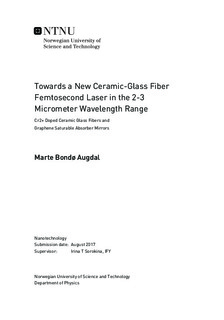| dc.description.abstract | Solid-state lasers, and in particular fiber lasers, are becoming the most commonly used lasers in science and industry, next only to diode lasers.
This work has targeted the development of two novel types of laser active and passive media, an active medium based on Cr:ZnSe ceramic glass fibers, and a graphene based silver saturable absorber mirror. These are the two most important constituent parts of a novel type of broadband femtosecond fiber laser operating in the very interesting wavelength range between 2.2 and 2.6 microns.
The main challenge in developing a broadband glass fiber active medium lies in the fact that fiber lasers are usually doped with rare-earth ions. These ions preserve their preferred valency also in the amorphous structure of the fiber laser, but yield narrowband lasers operating only at specific wavelengths. To develop a broadband, tunable laser, transition-metal ions must be used.
However, the aliovalent nature of these ions means that direct incorporation into a glass matrix leads to a range of valencies of the ions, inhibiting laser action.
To overcome this problem, in this work a new methodological approach was applied to solving this problem incorporation of ZnSe crystal micro-particles doped with Cr2+ into a phosphate glass matrix, retaining the valency of Cr2+ in the fixed local ZnSe crystalline environment of the ion.
To develop this new ceramic glass fiber, a number of technological steps have been undertaken.
- A standard melting technique was employed to fabricate phosphate glasses with low melting temperatures, and for incorporation of Cr:ZnSe into the glass matrix. This yielded the first reported successful incorporation of Cr:ZnSe particles in phosphate glasses, where the glasses were shown to retain the spectroscopic and luminescent properties of Cr:ZnSe.
- As the Cr:ZnSe micro-particles initially showed signs of dissociation at the high temperature, reducing the time of the Cr:ZnSe spent in the melted glass was identified to be a critical issue.
To further characterise the developed material, a number of characterisation steps have been undertaken:
- Absorption and fluorescence spectroscopy was performed. The fluorescence spectra showed spectra characteristic of Cr2+ ions, and an emission cross-section of the order of 10e-18 cm^2 was obtained at 2000 nm.
- A cut-back loss measurement technique showed that the losses in the glass were non-uniform across the samples, originating from the non-uniform distribution of Cr:ZnSe particles in the glass matrix. Large agglomerations of Cr:ZnSe particles led to large scattering losses, while regions of finely incorporated particles (< 1 micron) showed low losses.
- The gain was calculated and compared with the losses. The average losses over the sample, of about 6 cm-1 at 2000 nm, were slightly higher than the measured gain of about 4 cm-1, showing loss reduction as the critical parameter to focus on in order to achieve an efficient gain material. Areas of finely incorporated particles showed losses below 1 cm-1, showing that with homogeneous distribution of particles, the material will become even better as a laser material.
- Differential scanning calorimetry measurements were performed to identify the glass transition temperature at about 300 C, and Raman spectroscopy of the glasses were used to identify the Cr:ZnSe Raman peaks in the phosphate glass matrix.
The spectroscopic study shows the good prospects of this material as a laser material.
For creation of ultra-short pulses in the broadband fiber laser, a passive laser element - a saturable absorber - should be developed and incorporated into the laser. Graphene saturable absorbers on silver mirrors were created, and used to successfully mode-lock a Cr:ZnS laser.
In particular, the following technological and characterisation steps were undertaken:
- The graphene mirrors were fabricated by transferring CVD grown graphene from a Cu foil onto the silver mirror substrate by a standard transfer process. The process showed to be highly dependent on the handling of the materials, making it prone to human error. Difficulties with the adhesion of graphene to the underlying substrate were due to variations in the heat treatment, where soft baking on a hot plate made the process dependent on thickness and thermal conductivity of the substrate.
- The graphene saturable absorber on a silver mirror was used to successfully mode-lock a Cr:ZnS laser, yielding pulses of 100 fs with an input laser power of 3 W. The saturation energy fluence of the graphene saturable absorber mirror was calculated at 4.8uJ/cm2, significantly lower than commonly reported values, but agreeing with the observed trend that the saturation energy fluence decreases with increasing wavelength.
Summarising, the undertaken approach towards development of a novel ceramic glass fiber laser proved to be successful, and allowed to make two main conclusions:
- The developed ceramic glass fiber, preserving the valency of the active ions, showed promising spectral-luminescent properties as a laser active medium.
- The developed passive saturable absorber based on graphene mirrors demonstrated very good laser performance and could be used in the future ceramic glass fiber laser. | |

